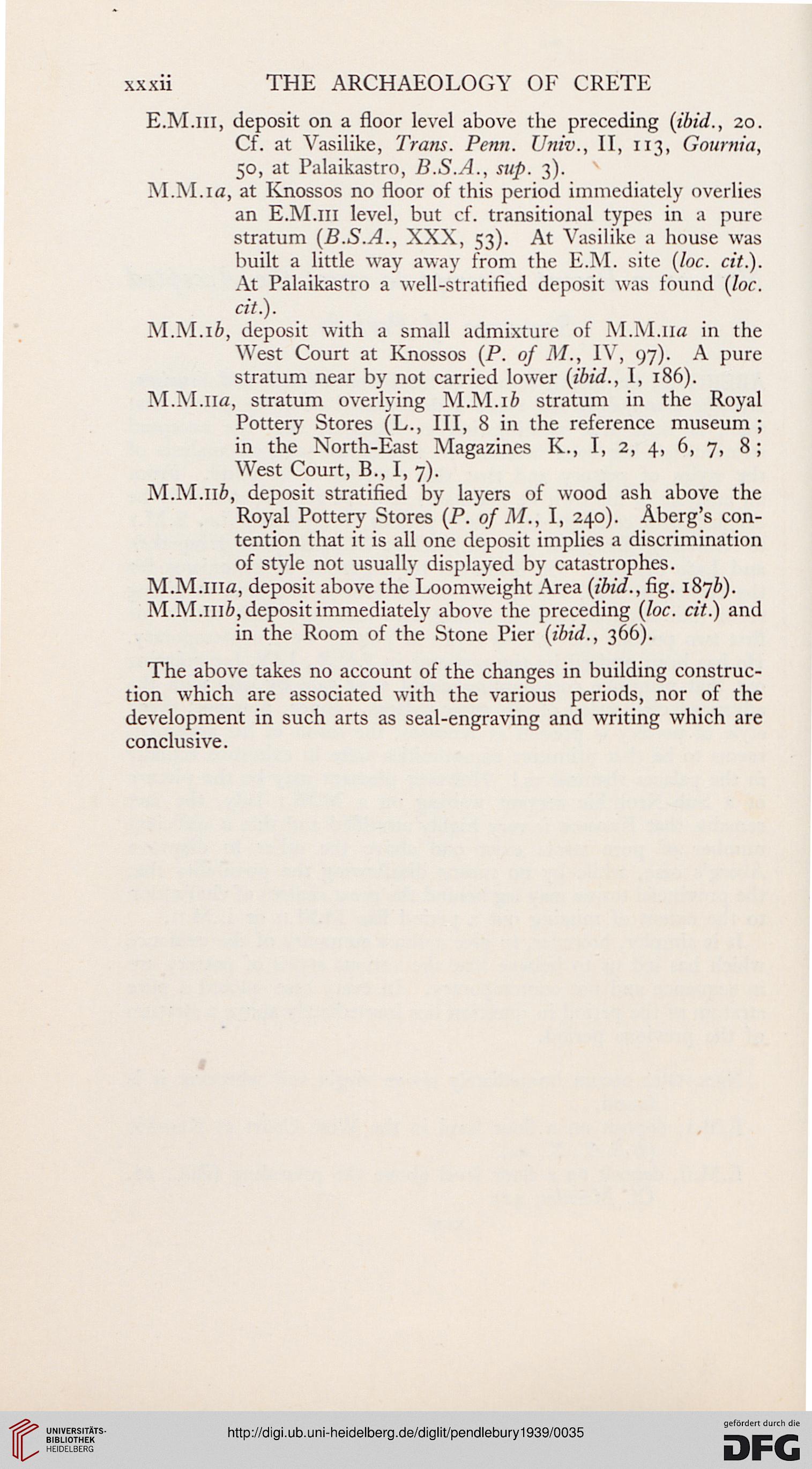xxxii THE ARCHAEOLOGY OF CRETE
E.M.ni, deposit on a floor level above the preceding (ibid., 20.
Cf. at Vasilike, Trans. Penn. Univ., II, 113, Gournia,
50, at Palaikastro, B.S.A., sup. 3). v
M.M.ia, at Knossos no floor of this period immediately overlies
an E.M.m level, but cf. transitional types in a pure
stratum (B.S.A., XXX, 53). At Vasilike a house was
built a little way away from the E.M. site (loc. cit.).
At Palaikastro a well-stratified deposit was found (/or.
at.).
M.M.10, deposit with a small admixture of M.M.na in the
West Court at Knossos (P. of M., IV, 97). A pure
stratum near by not carried lower (ibid., I, 186).
M.M.na, stratum overlying M.M.10 stratum in the Royal
Pottery Stores (L., Ill, 8 in the reference museum ;
in the North-East Magazines K., I, 2, 4, 6, 7, 8;
West Court, B., I, 7).
M.M.110, deposit stratified by layers of wood ash above the
Royal Pottery Stores (P. of M., I, 240). Aberg's con-
tention that it is all one deposit implies a discrimination
of style not usually displayed by catastrophes.
M.M.ina, deposit above the Loomweight Area (ibid., fig. 1876).
M.M.1116, deposit immediately above the preceding (loc. cit.) and
in the Room of the Stone Pier (ibid., 366).
The above takes no account of the changes in building construc-
tion which are associated with the various periods, nor of the
development in such arts as seal-engraving and writing which are
conclusive.
E.M.ni, deposit on a floor level above the preceding (ibid., 20.
Cf. at Vasilike, Trans. Penn. Univ., II, 113, Gournia,
50, at Palaikastro, B.S.A., sup. 3). v
M.M.ia, at Knossos no floor of this period immediately overlies
an E.M.m level, but cf. transitional types in a pure
stratum (B.S.A., XXX, 53). At Vasilike a house was
built a little way away from the E.M. site (loc. cit.).
At Palaikastro a well-stratified deposit was found (/or.
at.).
M.M.10, deposit with a small admixture of M.M.na in the
West Court at Knossos (P. of M., IV, 97). A pure
stratum near by not carried lower (ibid., I, 186).
M.M.na, stratum overlying M.M.10 stratum in the Royal
Pottery Stores (L., Ill, 8 in the reference museum ;
in the North-East Magazines K., I, 2, 4, 6, 7, 8;
West Court, B., I, 7).
M.M.110, deposit stratified by layers of wood ash above the
Royal Pottery Stores (P. of M., I, 240). Aberg's con-
tention that it is all one deposit implies a discrimination
of style not usually displayed by catastrophes.
M.M.ina, deposit above the Loomweight Area (ibid., fig. 1876).
M.M.1116, deposit immediately above the preceding (loc. cit.) and
in the Room of the Stone Pier (ibid., 366).
The above takes no account of the changes in building construc-
tion which are associated with the various periods, nor of the
development in such arts as seal-engraving and writing which are
conclusive.




